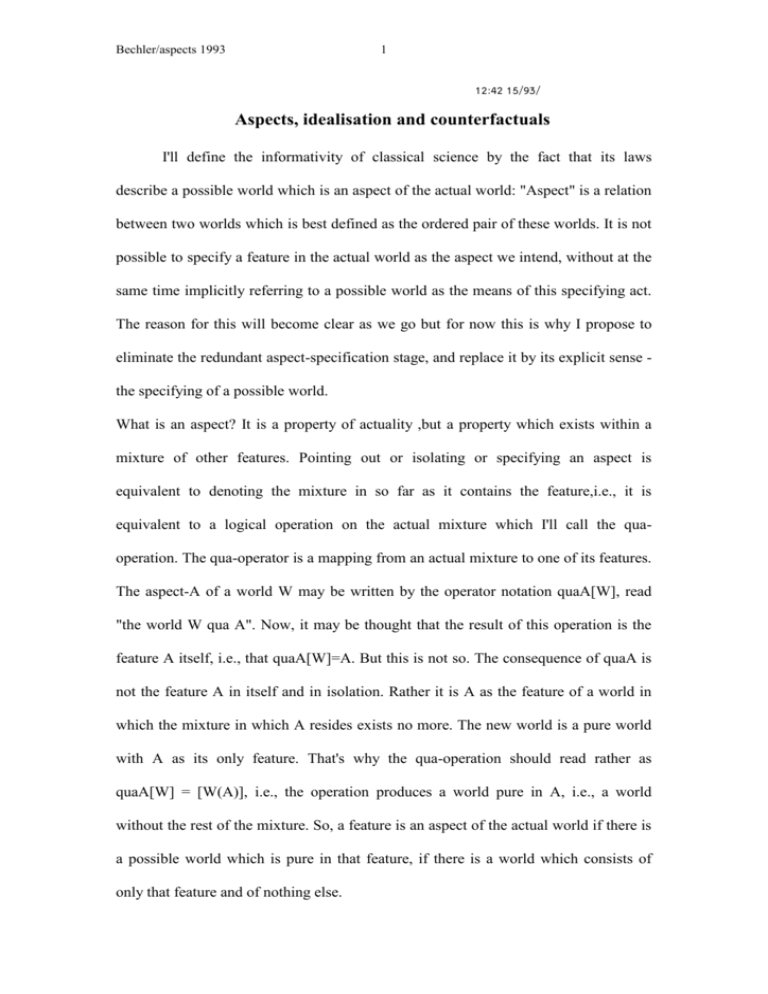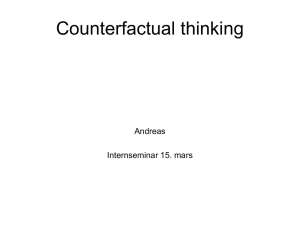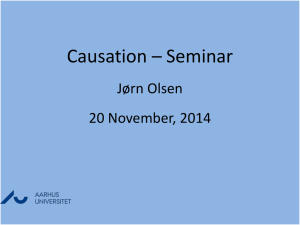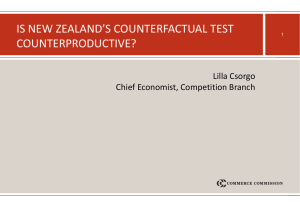Aspects, idealization and counterfactuals
advertisement

Bechler/aspects 1993 1 31:21 39/51/ Aspects, idealisation and counterfactuals I'll define the informativity of classical science by the fact that its laws describe a possible world which is an aspect of the actual world: "Aspect" is a relation between two worlds which is best defined as the ordered pair of these worlds. It is not possible to specify a feature in the actual world as the aspect we intend, without at the same time implicitly referring to a possible world as the means of this specifying act. The reason for this will become clear as we go but for now this is why I propose to eliminate the redundant aspect-specification stage, and replace it by its explicit sense the specifying of a possible world. What is an aspect? It is a property of actuality ,but a property which exists within a mixture of other features. Pointing out or isolating or specifying an aspect is equivalent to denoting the mixture in so far as it contains the feature,i.e., it is equivalent to a logical operation on the actual mixture which I'll call the quaoperation. The qua-operator is a mapping from an actual mixture to one of its features. The aspect-A of a world W may be written by the operator notation quaA[W], read "the world W qua A". Now, it may be thought that the result of this operation is the feature A itself, i.e., that quaA[W]=A. But this is not so. The consequence of quaA is not the feature A in itself and in isolation. Rather it is A as the feature of a world in which the mixture in which A resides exists no more. The new world is a pure world with A as its only feature. That's why the qua-operation should read rather as quaA[W] = [W(A)], i.e., the operation produces a world pure in A, i.e., a world without the rest of the mixture. So, a feature is an aspect of the actual world if there is a possible world which is pure in that feature, if there is a world which consists of only that feature and of nothing else. Bechler/aspects 1993 2 Laws of nature can be taken as aspects of the actual world, and then these aspects denote a possible world which is pure in these laws. To say that laws are ideal and do not exist in the actual world may now mean either of these two views: (1) Laws are an aspect of actuality. (2) Laws are an idealisation of actuality. These two views contradict each other. To be an idealisation is to be something that is not in actuality, but to be an aspect is to be in actuality, even though only as a component in a mixture. To be an idealisation is not to be a component at all but rather what actuality would become given such and such conditions acting on it. Idealisation then is not just counterfactual, it is also counteractual. But aspect is actual, not counteractual. This reflects a distinction between actuality and the means of its description: An aspect is an actuality that is described by means of a counterfactual, i.e., by means of a possible world. An idealisation is not only described by means of counterfactuals. Its mode of existence is counterfactual. It is not a component of actuality but rather what actuality as a whole would become under some specified conditions, and so it denotes what actuality is not as yet. Aspect, on the other hand, denotes what actuality is right now, under the contingent actual conditions which dominate it now, and prior to any changes that must take place in order to produce the new world. So both aspect and idealisation are possible worlds. They differ, however, in this crucial feature that the one is actual and the other may be even logically impossible. An idealisation may be, first, physically impossible in the sense that in this actual world it contradicts some of its laws, given its present population. Thus a world of masses and electricity and gravitation may be logically impossible without friction or with absolute rigidity, and then a no-friction or an absolute rigidity idealisation would be a contradiction. If an idealisation is taken as an operation on the Bechler/aspects 1993 3 actual world with its actual laws, and if the gravitational and electromagnetic constitution of matter is a part of the actual laws, then such idealisations as no-friction or absolute rigidity or absolute elasticity are logically contradictory operations. An aspect, on the other hand, is actual since it is a component and even a causal component. We say that red is one aspect of this apple, that generosity was one aspect of Hitler etc., meaning that these are actual causes in the existence of the apple, or Hitler, etc. On the other hand, we say that absolute justice is an idealisation since it does not exist in the actual world and is not one of its features, and may turn out to be a logical contradiction in it. But if aspects are actuals, then some puzzling features appear. For example, what about the actuality of the aspect quaS[Curve], i.e., this curve qua straight? Is it actual too? Or is it idealisation? It depends on your ontology of potentiality. Classical, Newtonian physics held that such aspects are actuals. A curved motion is composed of an inertial component and a centripetal component, and these are actuals since they are caused by two distinct forces, and these forces act during the whole motion independently of each other, each producing its own, independent effect. Consequently the notion of "the curved motion qua straight" means in Newtonian Physics just the straight component of the motion, and this component is actual since it is one cause of the resultant motion. This has nothing to do with idealisation and has nothing counterfactual in its nature, though it is or even must be described by a counterfactual. However, such description fails completely if the counterfactual describes not the component as it exists in the resultant, but rather how the component becomes a resultant under some new conditions. But this is not what the component is right now. Nor is it what the component is essentially. For to be a component is Bechler/aspects 1993 4 necessarily not to be a resultant. So what such a counterfactual describes is one part of the component but mot what it is, i.e., it describes the property of the component called "identity", i.e., it is the same motion when it is a resultant as when it was component, in the sense that it is represented by the same vector, i.e., direction and magnitude. But to be the straight component of a curved motion is to be all this plus being a component, i.e., a motion which combines with another motion but doesn't lose its identity. So another kind of counterfactual is needed to capture the being of a component. Saying that the straight motion is an aspect of the curved motion is to say not just that there is a possible world in which this motion exists in its pure state. It is to say this and also to add that this possible world is not different from the actual world at all. Rather that possible world is a component of the actual world and is, therefore actual, though not visible. But there are aspects which are visible as well, e.g. the redness of the apple, and which are thus possible worlds which are both actual and visible. What is this notion of a world which is possible (or potential) and yet actual? It is a world within a world. You may call it not only partial or componential world but also potential world. Its potentiality consists in its being only a component and not the resultant. We may say that the Newtonian component inertial velocity of a curved motion is an actual potential, its actuality denoting its causal role and its potentiality denoting its componential status. Being such a component, it is separate in a causal sense: It is distinct in its causal action from the rest of the causes which act simultaneously with it to make the whole motion. The best example, however, of such separateness is that of the Bechler/aspects 1993 5 Freudian instincts. The essence of the Freudian explanation is the hypothesis that behaviour is caused by several causes, some of them being instincts which are not known as such, severally, but which act invisibly and exist componentially. They are separate in the causal sense, just as Newtonian forces and their effects are, i.e., in that they are distinct things in a mixture, each with its own identity, action, and laws governing its career. Freudian instincts keep their identity and distinctness even while undergoing extreme transformations in their appearances and apparent modes of action. Indeed, one of Freud's most important discoveries was just this identity of instinct through its transformations, just as was Newton's discovery that what keeps the moon in its curved path around the earth and what causes stones to fall on the surface of the earth, was in fact one and the same force, which keeps its identity while changing in intensity. Hence even if it were the case that the only mode available to us for explicating the meaning of a componential entity is by a counterfactual which refers to pure, non-componential, circumstances, this would still be irrelevant to the ontological status of such entities. The limitation to modal descriptions of these entities ensues merely from the causal nature of their separateness. The only way to explicate the causative nature of any entity is by counterfactuals, but this does not mean that it does not act causally right now, in its positivactual situation. In this it differs crucially from those entities which are described counterfactually but have no positivactual reality right now, their only reality being conditional upon the realisation of some conditions. The reason they don't exist is that these conditions are also their causes so that as long as these conditions don't exist now, neither do their effects, i.e., the counterfactual entities. Bechler/aspects 1993 6 We may, then, pinpoint the difference between the two kinds of entities by the fact that their associated counter factuals describe, in the one case, the circumstances of their appearance in a pure state, and in the other case, the very causes of their existence. For causal entities, their associated counterfactuals denote a filtration operator (and I'll call it a filter-counterfactual), whereas for the entities whose existences are the effects of the counter factual conditions, these counterfactual denote causal, creative operation. I'll name it creation-counterfactual. The quantum crisis: Is there another counterfactual? Thus the dispute over the interpretation of QM may be described in these terms. We have, on the one hand, the Copenhagen interpretation (=CI) which holds that eigenstates are the effects of counterfactual creation operators, i.e., the experimental set-up. The dead cat and the live cat states are the effects of the set-up, which maybe even includes some observation by a conscious mind. The cat-states then either "live" or "dead" but only as qualified by a creation-counterfactual. Apart from this operator, there is no meaning to the concept of state at all. This is why it may be said that in CI all states are strictly relative, i.e., they are the effects but not causal effects of some conditions and have no reality apart from these conditions. The crucial defect in the CI is that this relativity is, actually and despite Bohr's intent, a causal process which links the conditions to their effect the state, but these processes are not described in QM. If also, part of these conditions are the observation by a conscious mind, the causal process seems rather to be non-describable by QM. The realist program in the interpretation of QM, on the contrary, takes the states of the cat to be only filtrated by the counterfactual conditions, and so to exist independently of these conditions and prior to them. Bechler/aspects 1993 7 Observation is taken to be a normal causal process which is prone to disturb the state of the observed system in the standard ways events disturb states, and so need not be any factor in the reality of the state. That is why we may "observe" a state without at all interfering with it, as the EPR argument shows. Since it usually is part of the counterfactual which filters the state, observation with nil interference may be a counterfactual filtration. Since a state is described in QM by a superposition, its componential eigenstates may be taken each as the actual state of the cat described probablistically. Superposition then turns out to be strictly an epistemic description, prefixed by a filter-counterfactual which says that under such and such condition one of the component states will be observed with such and such probability, simply because we don't know for certain which one of the components is the actual state. This may be called a "modal" interpretation, but not otherwise than as any classical componential explanation is "modal". Hence, on this realistic interpretation, the superposition in QM is epistemic in the sense that it descirbes uncertainty ensuing from ignorance. This may be compared with another realistic interpretation of the superposition, held by Schrödinger in regard to the QM superposition along the lines of the realistic interpretation of superposition in classical field theory. Here the superposition describes the components and their respective intensity as they all exist and act separately and simultaneously, composing thereby, as causes, the resultant wave for, their summative effect. The trouble with this realism in QM is that its associated counterfactual is a filter by collapse, i.e., by causation at a distance, a process not accountable by QM, again. As EPR showed, observation at one place must cause a collapse of the real superposition at a far away place simultaneously, and so in violation of special relativity. Bechler/aspects 1993 8 Moreover, this collapse must be deterministically selective, for the eigenstate surviving it at the distant place must fit exactly and necessarily the one observed here. All (maybe the infinitely many) component eigenstates of the distant system must be destroyed instantaneously except one, and this must be the one single eigenstate that fits the eigenstate observed here. EPR concluded that this excludes the realistic interpretation of the superposition as composed of actual componential eigenstates. Bell showed later on that EPR's positive conclusion from this refutation must be excluded as well. They concluded that since the realistic interpretation of the superposition in terms of filter counterfactual becomes causative and is inconsistent with special relativity, the superposition must be interpreted as epistemic and its associated counterfactual must be purely filter-operator, i.e., the superposition is ontologically incomplete because of our ignorance. Hence the system possesses or is in one of the eigenstates all the time. Bell showed that without deterministic causation-at-a-distance this is impossible as well. Hence, as long as locality plus determinism is kept, the counterfactual associated with the components of the QM superposition must be taken as creative. But since this cannot be creation at a distance, we do not know at present what kind of a counterfactual it is. This may, then, be a characterising of the present crisis in the interpretation of QM: The superposition associated counterfactual is neither a pure filter-operator nor a creation-operator, but there is no other kind of counterfactual operator by means of which we can explicate the meaning of the superposition.







